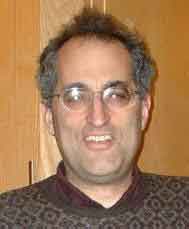.
Edward Witten

Edward Witten (*)
Edward Witten (born August 26, 1951) is an American theoretical physicist and professor at the Institute for Advanced Study. He is one of the world's leading researchers in superstring theory. He has made extensive contributions to theoretical physics, and in 1990 he was awarded the Fields Medal for his influence on the development of mathematics. In 1995, he suggested the existence of M-theory at a conference at the University of Southern California, and used M-theory to explain a number of previously observed dualities, sparking a flurry of new research in string theory called the second superstring revolution.
Birth and education
Edward Witten was born in Baltimore, Maryland [1] to a Jewish family, the son of Lorraine W. Witten and Louis Witten, a physicist specializing in gravitation and general relativity. He received his bachelor's degree in history (with a minor in linguistics) from Brandeis University. Witten planned to become a political journalist, and published articles in The New Republic and The Nation. He worked briefly for George McGovern's presidential campaign. Then, he attended the University of Wisconsin-Madison for one semester as an economics graduate student before dropping out. He then returned to academia, enrolling in applied mathematics at Princeton University before shifting departments and receiving a Ph.D. in physics in 1976 under David Gross, the Nobel laureate in Physics in 2004.
Academic career
After completing his PhD, he worked at Harvard University as a Junior Fellow and at Princeton as a professor. He was a Professor of Physics at Princeton University from 1980 to 1987. He also was briefly at Caltech for two years from 1999 to 2001. He is currently the Charles Simonyi Professor of Mathematical Physics at the Institute for Advanced Study in Princeton, New Jersey.
Research and achievements
Witten has made extensive contributions to theoretical physics, in work that has spawned a large number of highly mathematical results. He has been active primarily in quantum field theory and string theory, and in related areas of topology and geometry. His many contributions include a simplified proof of the positive energy theorem involving spinors in general relativity, his work relating supersymmetry and Morse theory, his introduction of topological quantum field theory and his related work on mirror symmetry and supersymmetric gauge theories, and his conjecture of the existence of M-theory.
Witten was awarded the Fields Medal by the International Mathematical Union in 1990, becoming the first physicist to win the prize. Sir Michael Atiyah said of Witten, "Although he is definitely a physicist, his command of mathematics is rivaled by few mathematicians... Time and again he has surprised the mathematical community by a brilliant application of physical insight leading to new and deep mathematical theorems... he has made a profound impact on contemporary mathematics. In his hands physics is once again providing a rich source of inspiration and insight in mathematics."[2] One such example of his impact on pure mathematics is his framework for understanding the Jones polynomial using Chern-Simons theory. This had far reaching implications on low-dimensional topology and led to quantum invariants such as the Witten-Reshetikhin-Turaev invariants.
He is currently working on the possible relations between Gauge theories and Geometric Langlands.
Personal life
He is married to Chiara Nappi, who is a professor of physics at Princeton University. His brother, Matt Witten, is a screenwriter and producer for several popular TV series including L.A. Law and House. His son, Rafael Witten, is a senior at Princeton High School and will be attending Stanford University in the fall of 2008.
Awards and honors
Witten has been honored with numerous awards, including a MacArthur Grant (1982), a Fields Medal (1990), the National Medal of Science (2002), and the Crafoord Prize (2008). Pope Benedict XVI also appointed Witten as a member of the Pontifical Academy of Sciences (2006). He also appeared in the list of TIME magazine's 100 most influential people of 2004.
Trivia
* Witten has the highest h-index of any living physicist;
* Witten was mentioned in the comic Ex Machina.
References
1. ^ http://www.jinfo.org/Fields_Mathematics.html
2. ^ Atiyah, Michael (2005). Michael Atiyah: Collected Works: Volume 6. Oxford Science Publications, 209,212. ISBN 978-0198530992.
Links
* Witten's web page at the Institute
* Witten theme tree on arxiv.org
* O'Connor, John J; Edmund F. Robertson "Edward Witten". MacTutor History of Mathematics archive.
* Edward Witten at the Mathematics Genealogy Project
Retrieved from "http://en.wikipedia.org/"
All text is available under the terms of the GNU Free Documentation License

